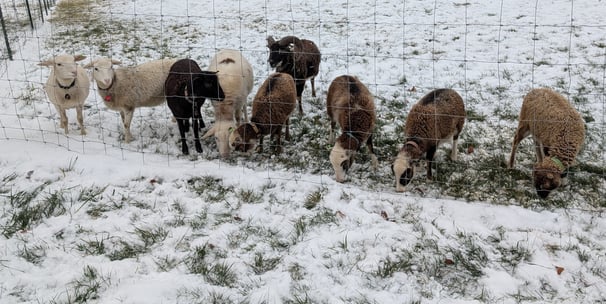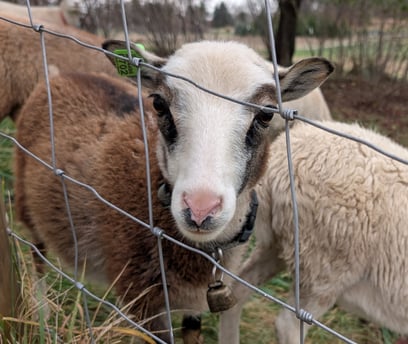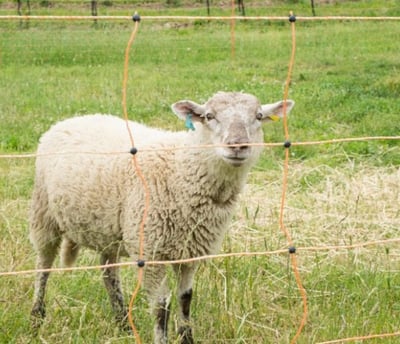Hoof Care
Proper hoof care is essential for the health, mobility, and overall well-being of your sheep. Overgrown or diseased hooves can cause pain, lameness, difficulty grazing, weight loss, and make sheep more susceptible to other issues. Here’s a guide to understanding and performing routine sheep hoof care:


Why is Hoof Care Important?
Mobility: Sheep need sound feet to walk, graze effectively, and escape predators.
Weight Bearing: Proper hoof shape ensures weight is distributed correctly, preventing joint issues.
Preventing Lameness: Overgrown hooves can curl under, trap debris, and create an ideal environment for bacteria, leading to painful conditions.
Disease Control: Regular checks allow you to spot and treat common hoof ailments like foot rot and scald early.
How Often Should You Trim Hooves?
There's no single answer – it depends on several factors:
Environment: Sheep on soft, wet pastures (like those often found in Michigan during certain seasons) will need trimming more often than sheep on hard, rocky, or dry ground, which naturally wears hooves down.
Breed & Genetics: Some breeds and individual sheep lines have faster-growing or harder/softer hooves.
Nutrition: Diet can influence hoof growth and hardness.
Age: Lambs' hooves grow quickly.
General Guideline: Plan to check your sheep's hooves every few months and trim them 2 to 4 times per year, or as needed. You'll trim more frequently during wet periods and less during dry periods. The key is regular inspection.


Regular hoof care is a non-negotiable part of responsible sheep ownership. It keeps your animals comfortable, mobile, and productive.


Tools You'll Need
Hoof Trimmers/Shears: Invest in a good, sharp pair designed for sheep or goats. Sharp tools are safer because they require less force and make cleaner cuts. Keep them clean and disinfected.
Gloves: Protect your hands.
Hoof Pick (Optional): Can help clean out packed mud or manure, though often less necessary than with horses.
Antiseptic Spray (Optional but Recommended): Keep something like iodine, Blu-Kote, or Kopertox on hand in case you accidentally cause minor bleeding.
How to Trim Sheep Hooves: Step-by-Step
Catch and Restrain:
Calmly gather the sheep.
The most common method is "setting up" the sheep: Stand beside the sheep, turn its head back towards its tail, reach under its body, grab the far-side legs (front and back), and gently lift and tip it backward so it sits on its rump, leaning against your legs. Most sheep become calm in this position.
Alternatively, you can use a handling chute, a trimming stand, or a turnover crate if you have one.
Clean the Hoof: Use the tip of your trimmers or a hoof pick to gently remove any mud, manure, or bedding packed into the hoof. This allows you to see the hoof structure clearly.
Inspect the Hoof: Look for any signs of problems (see below) before you start trimming.
Identify the Parts: Note the hard outer hoof wall and the softer sole underneath. Look for the natural growth lines.
Trim the Hoof Wall: The goal is to make the bottom of the hoof flat and level, like the sole of a shoe.
Carefully trim the overgrown outer hoof wall, snipping off small pieces at a time. Work your way around the edge.
Your goal is to make the hoof wall level with the sole. Stop when the sole starts to look flat and you see healthy white/ivory tissue.
Level the Heel and Toes: Trim any overgrown heel or toe areas to achieve that flat, weight-bearing surface.
Be Cautious with the Sole: Avoid trimming too much off the sole itself unless it's clearly overgrown and flaky. The sole protects the sensitive structures underneath.
Watch for Pink!: If you start to see a pinkish tinge in the sole, STOP trimming that area immediately. Pink means you are getting close to the "quick" – the blood supply. Cutting into the quick causes pain and bleeding and can lead to infection.
If You Cause Bleeding: If you accidentally cut too deep, don't panic. Apply pressure for a minute or two. Once it stops, spray the area with an antiseptic. Monitor the sheep for a few days to ensure no infection develops.
Repeat: Trim all four hooves, checking your work to ensure they are level.
Common Hoof Problems to Watch For
Foot Scald: An inflammation between the toes (interdigital space), often looking red and raw. It's usually caused by wet, muddy conditions and can be a precursor to foot rot.
Foot Rot: A highly contagious bacterial infection characterized by a foul smell, separation (undermining) of the hoof wall from the sole, and grey/black, dead tissue. It causes severe lameness. Requires aggressive trimming (to expose bacteria to air) and often treatment with foot baths or sometimes antibiotics.
Abscesses: Pockets of infection, often starting from a puncture wound or crack. Causes intense pain and lameness, often with swelling. May need lancing and treatment.
Cracks & Deformities: Can occur due to injury, nutritional issues, or chronic overgrowth.
Prevention is Key
Regular Trimming: The most important preventative measure.
Good Drainage: Ensure pens, shelters, and high-traffic areas are as dry as possible.
Pasture Rotation: Helps reduce exposure to bacteria-laden areas.
Foot Baths (Use with Caution): Medicated foot baths (often Zinc Sulfate – which is safer than Copper Sulfate for sheep) can help prevent and treat scald and foot rot, especially during wet seasons. If using Copper Sulfate, be extremely cautious due to sheep's sensitivity to copper poisoning.
Biosecurity: Quarantine new animals and inspect their feet before adding them to your flock.
Culling: Consider removing sheep that suffer from chronic hoof problems, as there can be a genetic component.
